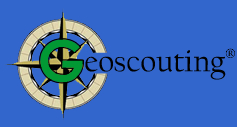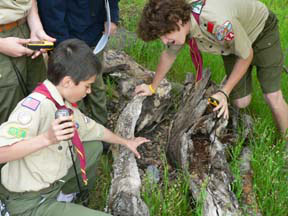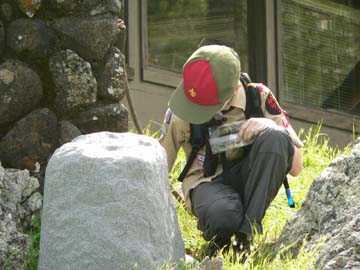

| home |
| introduction |
| cache to eagle |
| rules |
| activities |
| games |
| order |
| resources |
| forum |
| contact |
| Geoscouting Games |
Sample Geoscouting Game - Introductions Sample Geocache game for a troop meeting or recruiting event This is a good game to play with new teams. It both introduces inexperienced players to the sport and demonstrates how you can use geocaching games that have a hidden purpose – in this case team introductions Ask the boys how many are familiar with geocaching. Divide the teams so that they have a mix of experienced and inexperienced users. It is good if they do not know all the members on their team – but do NOT do introductions yet. That will be a part of the game. Note: Before the course, the instructors must find easy hiding spots for 3 caches. All waypoints should be pre-programmed into the GPS units, as this session does not focus on programming the GPSr, but only on finding a cache. These can be as simple as having the cache sitting on the tire of a car in the parking lot – the point is simply to have the participants have a chance to follow the arrow of the GPS unit and experience the thrill of the find. Explain the challenge Go outside of the building to the parking lot or other suitable spot where there is good GPS reception. It must be close by to stay in the timeframe of the session – the outside portion of the game can only take about 15 minutes. Have each team look at their GPS unit – it should be pre-activated so that is has acquired the satellites. Explain the initial screen, and point out that the GPSr has tracked the satellite signals. Then the staff member illustrates how to go to the “Find Waypoint” screen to bring up the compass arrow.
As the team prepares to begin hunting, explain the team rules as follows; 1. All team members should “STAY TOGETHER” 2. Do not RUN – WALK (no need to get injured) 3. Do not tread on things you shouldn’t (gardens, private property, etc) 4. Attempt to involve everyone on the team. Everyone should have a job 5. Each team should have a Troop Guide (staff member) to chaperone the team. Do not ditch the troop guide.
Have the teams go outside and assemble with their teams in an open area near the training facility. Once assembled, get everyone’s attention.
Perform a very brief explanation of GPS operation with everyone. Explain that the GPSr is tracking the signals of the satellites that are currently in the horizon sky. As each GPSr establishes signal connection with at least 3 satellites the screen should say “Ready to Navigate”. Explain that the Accuracy shown will change depending on the number of satellites tracked and the amount of interference of the signals, such as traveling in dense trees may degrade the signal decreasing the accuracy of the GPSr.
Have all team proceed to the first waypoint 001, and meet them there. (The teams should then begin traveling in the direction the GPSr indicates.) Waypoint One:The first cache should contain nametags of the participant, which are color coded. In case participants have not pre-registered, have blank nametags and a pen in the cache in addition to the pre-done nametags. Have them introduce themselves to their team as they put on their nametags. Once everyone has located the first cache they should have a good feel how this game works. Show everyone the cache container so everyone knows what he or she is looking for. Make the hide simple as this is a learning exercise. They simply need to find 2 more caches and do what it says to do at the site. An experienced adult or youth member will accompany the team to help them change the GPS coordinates to the next waypoint. There is not time for teaching how to program the GPS unit in this training but this will be covered in detail at the later, fully hands-on outdoor training session. Entertain any questions and tell them they need to be back at the meeting room in 15 minutes from now. The entire team needs to be present at the classroom to be considered on time. Waypoints Two and Three:Send them out to find two more easy caches. The second cache will have a small trinket or gift – like an inexpensive pin or CITO container. Everyone gets a prize. The third cache will have “getting to know me” questions. These are easy ice-breaker questions, like “Find someone who is an Eagle Scout” or “Find someone who has been to Philmont.” Questions are also color coded. They simply take a question, and then return to the classroom.
Following the exercise, have the participants return to the meeting area. As they reassemble, have them introduce themselves to another Scouter and ask the question they got from the 3rd cache. If the question is on yellow paper, they need to ask someone with a yellow nametag. Take 2-3 minutes to do this. At the end of this exercise, they should have had some fun, and gotten to know a little about the rest of the participants. The hidden point of the game is to have the team get to know each other, and to provide a small gift (such as a Cache In Trash Out token) that will support the material to come later in the course. This point will be debriefed when they reassemble. Ask the participants if they had fun. Ask if they learned anything. See if they come up with the fact that they accomplished the introduction and ice-breaker portion of the training in a novel manner. If they don’t, explain what you did. Tell then that they will understand the significance of the gift (CITO container) shortly when we explain Geocaching and Service ideas. You may want to have prizes for games or events. A low cost recognition item is a simple “cache in, cache out” container – these are low cost (requires only a film canister with a label and a plastic trash bag) and yet supports the Leave No Trace aspect of Geocaching, and can make a great, easily personalized gift for participants. This can supplement the prize they picked up in the second cache during the game.
Remember – Scout troops are Boy led - Share your knowledge with the Troop Youth Leadership, and turn the planning and implementation of events over to them to the greatest degree possible.
|
|
||
Home | Introduction | Cache to Eagle | Rules
Activities | Games | Order | Resources | Contact
Copyright © 2006-2016 Mary E. Stevens

